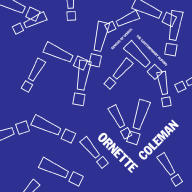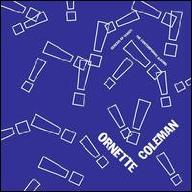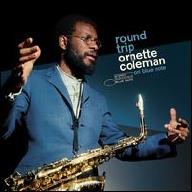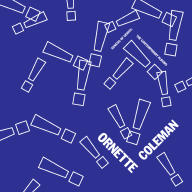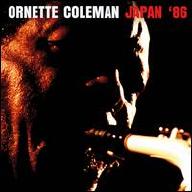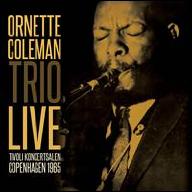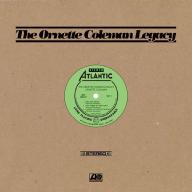Randolph Denard Ornette Coleman was born in Fort Worth, Texas in 1930. He was drawn to music early on, playing kazoo with friends and imitating the sounds of the big bands that came through town. Coleman grew up poor. His father died when he was seven, forcing him to find odd jobs working at night after school let out. His mother, a seamstress, worked long hours and eventually saved enough to buy him his first alto saxophone at 14. He attended the city's I.M. Terrell High School, where he focused on music. In band class he met and played with Dewey Redman, Charles Moffett, King Curtis, Prince Lasha, and John Carter. Under the influence of a local saxophonist named Red Connors, who impressed upon him the importance of reading music, Coleman taught himself to sight read.
At 15 Coleman began playing a tenor horn in various jump bands and traveled to New York City to visit an aunt. There he was exposed to the emerging bebop revolution and returned to Fort Worth anxious to share his discovery. At 16, Coleman quit school, worked to help his mom, and formed the Jam Jivers with Lasha and Moffett. They initially played jump blues in R&B rooms and at sock hops. They eventually began playing bebop, too. Coleman often sat in with traveling jazz musicians, working on his bop chops without rejecting R&B. That trait -- his refusal to discriminate between types of music -- remained a pillar in his creative philosophy for the rest of his life.
In 1949, Coleman sat in with Silas Green's traveling minstrel troupe from New Orleans and subsequently joined his band. In 1950, he worked the road with bluesmen Clarence Samuels (where he met and played with New Orleans-born Ed Blackwell) and Pee Wee Crayton. During tours with the minstrel shows and blues bands, everyone from his bosses to ticket holders criticized his freer, blues-based playing style. In Baton Rouge, Coleman was beaten unconscious by local rednecks who didn't appreciate his soloing, bop leanings, or unconventional tone. They smashed his tenor horn, too. His response? He switched back to alto and purchased a white plastic Grafton horn similar to Charlie Parker's.
After leaving Crayton, Coleman spent time in a local R&B band in Amarillo. When the bluesman passed through Texas again, Coleman rejoined his band. They toured the American south and west and played a run of dates in Los Angeles in 1951. The work dried up and Coleman returned to Fort Worth the following year. At home there were service jobs and club work, but little to challenge him artistically. He began constructing his own systematic ideas about harmony, melody, and rhythm, and they became the root foundations of the harmolodic system he developed a few years later.
In 1953, with few prospects, Coleman opted to give Los Angeles another try. He reconnected with Blackwell, who had moved from Texas some months earlier. They shared a house in Watts and began formulating the harmolodic system, and worked many straight jobs because Coleman's playing style was off-putting to some club owners and many musicians who felt he didn't understand music or how to play his horn. He met and was befriended by Angelino drummer Billy Higgins and two Oklahoma expats, bassist Charlie Haden and trumpeter Don Cherry. All three were teens. Coleman also met and fell in love with poet and activist Jayne Cortez; they married in 1954 and had a son, Denardo, in 1956. They divorced in 1964 but remained close.
Blackwell returned to New Orleans in 1958, just before Coleman signed a record deal with Lester Koenig's Contemporary label. With Higgins, Cherry, bassist Don Payne, and pianist Walter Norris, he recorded Something Else!!!! The album shook things up on the jazz scene as critics and musicians -- including some of his more established sidemen -- couldn't accept Coleman's ideas about tonality, phrasing, or rhythm. That said, the harmonic blues interplay between the frontline players remains remarkable more than half-a-century later.
Coleman followed with 1959's Tomorrow Is the Question! He banished the piano and worked with Cherry, drummer Shelly Manne, and bassists Percy Heath and Red Mitchell. Though it received a more generous reception -- two of the album's greatest champions were John Coltrane and Cecil Taylor -- it was still burdened by the unforgiving attitudes of unsympathetic sidemen (Manne and Mitchell) and what critics erroneously perceived as a lack of cohesion.
That April, Coleman signed with Atlantic Records. In May he cut The Shape of Jazz to Come with Higgins, Haden, and Cherry. He originally wanted the title to be "Focus on Sanity" (after its fourth track) but label boss Ahmet Ertegun convinced him that his own title offered listeners a peremptory idea of the album's importance. Ertegun was correct. The set contained two of Coleman's most enduring compositions, "Lonely Woman" and "Peace." That October, just before its release, the Coleman quartet returned to the studio to record Change of the Century.
By the time Shape of Jazz to Come was issued in early November, the Coleman quartet began what was supposed to be a two-week residency at the Five Spot arranged by the Modern Jazz Quartet's John Lewis. The gig created a firestorm of publicity in the press and the jazz community. It was attended and hotly debated by almost every jazz musician and critic in New York, and the band's sold-out run was extended to ten weeks: Miles Davis hated Coleman's music, but Leonard Bernstein, Sonny Rollins, and John Coltrane loved it. Charles Mingus claimed he didn't understand it, but was deeply moved by it nonetheless. Roy Eldridge was among the harshest critics; he called Coleman's music "fraudulent." Following that stand, Change of the Century was released in May 1960, to wildly contrasting reviews.
On December 21, Coleman assembled a double quartet in a New York studio that included bassists Haden and Scott LaFaro, drummers Blackwell and Higgins, trumpeters Cherry and Freddie Hubbard (an early detractor whom Coleman won over), and Eric Dolphy on bass clarinet. Adorned with a die-cut cover inset with painter Jackson Pollock's "White Light," Free Jazz opened the floodgates for vanguard music. Employing only a few brief pre-composed sections, the music was improvised by this large group in single takes with no overdubs or edits. After its release in 1962, Downbeat published two contrasting reviews -- that summed up a larger split among musicians, critics, and fans -- one article awarded its highest rating of five stars, while the other awarded none. Free Jazz ultimately became the template for two other historic jazz masterworks: Coltrane's Ascension and Peter Brötzmann's Machine Gun.
Between May 1959 and March 1961, Coleman recorded enough material for nine albums and released This Is Our Music (with Blackwell replacing Higgins), Ornette! (with LaFaro replacing Haden), Ornette on Tenor (with Jimmy Garrison on bass), and three albums released long after he left the label: Art of the Improvisers (1970), Twins (1971), and To Whom Who Keeps a Record (1975). All were compiled by Rhino in the 1993 box set Beauty Is a Rare Thing.
While the Atlantic albums had an immediate cultural impact, Coleman was discouraged and angry about the state of his career by the end of 1962. Atlantic canceled his contract, club owners and concert promoters exploited him or wouldn't book him, and most critics possessed little to no understanding of his music. He believed racism was the key reason. Coleman retreated from recording and playing live music for just over two years. During his self-imposed exile, he continued refining the harmolodic system and taught himself to play violin and trumpet. When he returned to action, it was with a new trio featuring bassist David Izenzon (a classical musician who had picked up the jazz double bass at 24) and high school friend Charles Moffett on drums. Two years earlier, Coleman composed and recorded Chappaqua Suite, a rejected score for a Conrad Rooks film that also included Pharoah Sanders on tenor. The project paid well enough for Coleman's trio to tour Europe. Chappaqua Suite was eventually released in 1966 by CBS Europe.
In December 1965, after touring for a couple of months, Coleman booked his new trio into the edgiest jazz club in Stockholm, the Gyllene Cirkeln (Golden Circle) for a two-week run. He had signed to Blue Note earlier that fall and the label recorded two shows, which were quickly released in 1966 as At the Golden Circle Stockholm: Vol. 1 & Vol. 2. These outings showcased Coleman playing his new instruments and alto in compositions and improvisations that went further out than anything he'd done before. They revealed a new emotional resonance in his own tone as well as a controlled palette of microtones that he could employ rhythmically and harmonically. While the Swedes and other Europeans embraced Coleman as a prophet of the new, critics and jazz fans in the U.S. were still having a very difficult time understanding his music.
Coleman cut five albums for Blue Note. His first date for the label was the wildly controversial studio outing The Empty Foxhole with Haden on bass and ten-year-old Denardo on drums. Critics and jazz musicians derided the album because of his son's inexperience. Coleman didn't include him because he was a master drummer, but because Denardo's emergent emotive playing style provided the saxophonist with the kind of melodic counterpoint he now found central to his music. In 1967, Coleman appeared as a collaborating sideman on Jackie McLean's New and Old Gospel, playing trumpet exclusively. Comprising a side-long suite by McLean and two Coleman tunes on the flip, the record got mixed reviews, but McLean considered it one of his most inspired recordings.
Vanguard classical musicians, critics, and listeners were beginning to embrace Coleman's advanced music. That year he collaborated with the Philadelphia Woodwind Quintet and the Chamber Symphony of Philadelphia Quartet. They recorded three of his works in New York City for The Music of Ornette Coleman, issued by RCA in the U.K. Coleman was awarded the first of two Guggenheim fellowships. He returned to Blue Note for a pair of quartet dates cut in two sessions nine days apart in the spring of 1968: New York Is Now! and Love Call. His lineup on both included drummer Elvin Jones and bassist Jimmy Garrison from Coltrane's quartet, and high school friend tenor saxophonist Dewey Redman, who was also making a name for himself in New York. Despite the rhythm section's star power and their "big beat" intensity, neither album sold very well and Coleman left the label.
He signed with Impulse in July 1968, and released Ornette at 12 in early 1969. Its lineup included Haden and Redman, and marked the return of Denardo, age 12 (hence the title). Critics savaged it, but by this time Coleman no longer cared. He understood his son's gift and potential. Denardo eventually became his primary drummer, music director, and manager, roles he served for the rest of his father's life. Coleman also recorded Crisis for the label. Recorded in concert at New York University in 1969, it marked the return of Cherry to Coleman's employ alongside Haden, Redman, and Denardo; it went unreleased until 1972.
In early 1971, Coleman signed with Columbia. In April he brought a slew of alternating musicians into a New York studio including Higgins, Blackwell, Haden, Redman, and Cherry. Also joining the proceedings were trumpeters Jacques Schwarz-Bart and Bobby Bradford, and vocalist Asha Puthli. These bracing free sessions resulted in Science Fiction, Coleman's most popular album since leaving Atlantic. In the 21st century it still sounds ahead of its time. These exploratory sessions netted an abundance of quality material; the balance appeared in 1982 as Broken Shadows.
In April of 1972 Coleman teamed with the London Symphony Orchestra and recorded his first large-scale orchestral work, Skies of America. Initially conceived as a concerto grosso for jazz quartet and orchestra, the musicians union in England wouldn't allow Coleman's band to play on the album. As such, he contributed to several interludes solo. This set marked the first time Coleman's harmolodic system was employed on such a grand scale. American critics Robert Palmer and Bill Milkowski enthusiastically embraced it, as did several others. Commercially it fared well in Europe -- where it got radio play -- and it sold respectably in the U.S. It and Science Fiction have undergone major critical reappraisals in in the late '90s and 2000s, and are now considered masterworks. Coleman received his second Guggenheim Fellowship for Skies of America. In 1975, a compilation of unissued recordings from the Atlantic period appeared as To Whom Keeps a Record.
Coleman signed a one-off deal with AM's Horizon imprint and showcased his harmolodic funk band, Prime Time. The lineup included two electric guitarists in Bern Nix and Charles Ellerbee, two drummers in Denardo and Ronald Shannon Jackson, and electric bassist Jamaaladeen Tacuma. Their debut album, 1977's Dancing in Your Head, turned jazz-funk and vanguard jazz upside-down. The A-side offered two variations of "Theme for a Symphony" -- one instantly memorable melodic vamp played incessantly with cyclical soloing by all members. The flip, "Midnight Sunrise," was a sprawling collaboration with Morocco's Master Musicians of Jajouka. Sympathetic critics embraced it and compared it to the music of Parliament-Funkadelic and Sly Stone. Interestingly, some even favored it over Miles Davis' electric offerings (leading to a reassessment of Coleman by the trumpeter). It was the first jazz album to ever enter the Village Voice's Pazz & Jop Poll.
Coleman took Prime Time (sans Denardo) on tours of Europe and Japan. In Paris they entered a recording studio and cut the quintet sessions that would become 1978's Body Meta for Artist House (named after Coleman's term of endearment for his famous Prince Street loft). In 1977, Coleman and Haden recorded the acclaimed duet offering Soapsuds, Soapsuds for the same label. In 1978, Coleman, Denardo, and Tacuma backed electric guitarist James Blood Ulmer on his Artist House debut, Tales of Captain Black and toured with him.
In 1979, Prime Time entered CBS Studios in New York City with Denardo and drummer Calvin Weston. There to record a direct-to-disc outing that failed due to mechanical problems; they ultimately emerged with the first digitally recorded jazz album, 1982's Of Human Feelings. Released by Island subsidiary Antilles, it received global acclaim and registered positive notice in the U.K. from DJs such as John Peel. Unfortunately, it sold poorly and was soon deleted.
Following a dispute over royalties, Denardo replaced Coleman's manager. In 1985, Coleman and Prime Time played the inaugural concert at Caravan of Dreams, a performing arts space, gallery, and record label in his hometown of Fort Worth. The lineup included Denardo and Sabir Kamal on drums, Ellerbee and Nix on guitars, and Tacuma and Al McDowell on bass. It resulted in the album Opening the Caravan of Dreams.
Guitarist Pat Metheny had been a lifelong admirer of Coleman's. He'd cut the saxophonist's tunes on albums such as Bright Size Life, 80/81, and Rejoicing, and employed his sidemen. Metheny had just left ECM for Geffen and made a stipulation of his signing that he get to record with Coleman. They cut the co-billed Song X over three days in 1985. The lineup included Haden, Denardo, and Jack DeJohnette. It garnered glowing reviews, as Metheny's guitar synthesizer uncannily matched the tone of Coleman's horn. Metheny fans, however, had a harder time with the collaboration. The band's concert at the University of Michigan's Hill Auditorium found Coleman's fans enthusiastic about the performance, even as hundreds of Metheny fans streamed for the exits shortly after it began. The following year, Coleman released the double-length In All Languages for Caravan of Dreams. His 1950s quartet performed on one record while Prime Time played on the other.
On September 18, 1987, Coleman, Denardo, and Cecil Taylor attended a Grateful Dead concert at Madison Square Garden at the invitation of Dead bassist Phil Lesh (a longtime fan of both the pianist's and the saxophonist's). Witnessing the crowd's enthusiasm inspired Coleman to conceive, write, and record the album Virgin Beauty for Portrait Records in 1988. It presented Prime Time in a more accessible setting that included the Dead's guitarist Jerry Garcia as a guest on three tracks. (Coleman would later return the favor and perform with the Grateful Dead at a 1993 concert.) The album's airy, synthetic production values were drawn from pop music. The harder funk and R&B elements were all but absent -- they were replaced by a more dynamic, hybridized take on world music. It became Coleman's best-selling album, which makes it seem a bit strange that Prime Time wouldn't record again for seven years.
In 1990, the city of Reggio Emilia in Italy held a three-day "Portrait of the Artist" tribute to Coleman featuring his 1950s quartet. The festival also presented performances of his chamber music and Skies of America. In 1991 Coleman worked with composer Howard Shore to compose and record the score and soundtrack for David Cronenberg's Naked Lunch along with the London Symphony Orchestra. The recording offers the rare opportunity to hear Coleman playing a standard: namely, Thelonious Monk's "Misterio." In 1994, the saxophonist was awarded a MacArthur Foundation "genius" grant.
Coleman founded his own Harmolodic label and signed a distribution deal with Verve. They reissued In All Languages in 1994, and in 1995 released Prime Time's Tone Dialing. This version of the band included guitarists Chris Rosenberg and Ken Wessel, bassists McDowell and Bradley Jones, Badal Roy on percussion, Denardo on drums, and Chris Walker and Dave Bryant on keyboards. Coleman also appeared on pianist Geri Allen's Eyes in the Back of Your Head that year.
In 1996 Coleman released two albums simultaneously: Sound Museum: Three Women, and Sound Museum: Hidden Man. Thirteen of his compositions were performed in radically different versions on both releases by the same quartet: Allen (the first pianist he'd worked with since the '50s), bassist Charnett Moffett, and Denardo. The lone vocal track "Don't You Know by Now" featuring Lauren Kinhan and Walker, appeared only on the former title. Later that year, Coleman and pianist Joachim Kuhn recorded a duet concert in Poland. It was released in 1997 as Colors: Live from Leipzig.
In 2000, Coleman made an unlikely sideman appearance on singer/songwriter/producer Joe Henry's album Scar. Henry claimed that Coleman initially turned him down, but after the saxophonist heard what he considered an unusual grain in the singer's voice, he eventually agreed. The pair also played a duo concert at New York's Town Hall. In 2005, Geffen remastered and reissued Song X in a greatly expanded edition.
The last album to appear under Coleman's name during his lifetime was Sound Grammar in 2007. A live offering, it was recorded two years earlier at a festival in Ludwigshafen, Germany. His quartet featured bassists Greg Cohen and Tony Falanga with Denardo on drums. That year, the Grammy Foundation presented the saxophonist with a lifetime achievement award. In September of 2010, Coleman made a guest appearance at Sonny Rollins' star-studded Sonny@80 Concert in New York City. They performed "Sonnymoon for Two" with bassist Christian McBride and drummer Roy Haynes. The track appeared on Roadshows, Vol. 2. Coleman also appeared on Tacuma's 2011 tribute album For the Love of Ornette. Though Coleman continued to work with other musicians, he issued no further recordings. He died on June 11, 2015, at age 85.
In 2022, Blue Note issued the archival six-LP box set, Round Trip: Ornette Coleman on Blue Note as part of its celebrated Tone Poet series, and Craft Recordings reissued his Contemporary albums in a deluxe vinyl package titled Genesis of Genius. ~ Thom Jurek, Rovi


